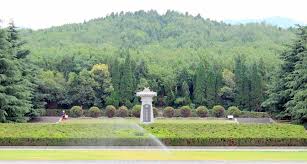
Is the Mausoleum of the First Qin Emperor Real?
The Mausoleum of the First Qin Emperor, a testament to ancient Chinese engineering and ambition, stands shrouded in a veil of mystery and wonder. While historical records strongly suggest its existence, the question remains: is it real? And if so, what secrets lie hidden within its depths?
Historical Records and Archaeological Evidence
The construction of the mausoleum commenced in 246 BC, under the reign of Qin Shi Huang, the first emperor of a unified China. It took 39 years to complete, finally standing as a grand symbol of his power and legacy. Historical records, primarily the "Records of the Grand Historian" by Sima Qian, provide detailed accounts of the mausoleum's construction, contents, and layout. These accounts describe a vast underground palace filled with unimaginable treasures, intricate mechanisms, and a ceiling adorned with celestial bodies.
Archaeological investigations, initiated in the 1960s, have further solidified the historical narrative. The discovery of the Terracotta Army, an army of life-sized terracotta soldiers, horses, and chariots buried near the mausoleum, served as a monumental confirmation of its existence. Further excavations have revealed the vast scale of the complex, with two walls enclosing the inner and outer cities of the mausoleum. The inner city, encompassing an area of 2.5 square kilometers, is believed to house the emperor's tomb, while the outer city, spanning 6.3 square kilometers, contains various ancillary buildings and tombs.
The Enigma of the Unexplored Tomb
Despite decades of research and exploration, the central tomb of Qin Shi Huang remains unopened. This conscious decision stems from several factors:
- Respect for the Deceased: Chinese culture places great emphasis on respecting the dead and their resting places.
- Technological Limitations: The tomb's structure, as described in historical records, suggests the presence of complex booby traps and potential hazards that current technology may not be equipped to handle safely.
- Preservation Concerns: Opening the tomb could expose the interior to the elements, potentially damaging priceless artifacts and murals.
This cautious approach ensures the preservation of this historical treasure for future generations, but it also fuels further speculation and intrigue.
The Enduring Legacy of the Mausoleum
The Mausoleum of the First Qin Emperor, even in its unopened state, stands as a testament to the grandeur and ambition of ancient China. It serves as a window into the past, offering glimpses into the architectural prowess, artistic brilliance, and cultural beliefs of a bygone era. The meticulous craftsmanship of the Terracotta Army, the sheer scale of the complex, and the mysteries still entombed within its depths continue to captivate the world's imagination.
While the question of when, or even if, the central tomb will ever be opened remains, one thing is certain: the Mausoleum of the First Qin Emperor will forever be an enduring symbol of China's rich history and a source of endless fascination.
Q&A
What is the significance of the Terracotta Army?
The Terracotta Army is significant because it provides tangible evidence of the historical accounts of Qin Shi Huang's mausoleum. The army's size, detail, and craftsmanship offer invaluable insights into the military practices, artistry, and cultural beliefs of the Qin Dynasty.
Why hasn't the main tomb been excavated?
Out of respect for the deceased and due to concerns regarding potential damage to the tomb's contents, the Chinese government has chosen not to excavate the main tomb. This decision reflects a commitment to preserving the site for future generations.
What can we learn from the Mausoleum of the First Qin Emperor?
The mausoleum provides a wealth of information about ancient Chinese civilization, including their architectural skills, burial practices, artistic traditions, and the political ideology of the Qin Dynasty. It serves as a physical link to the past and offers valuable insights into a pivotal period in Chinese history.